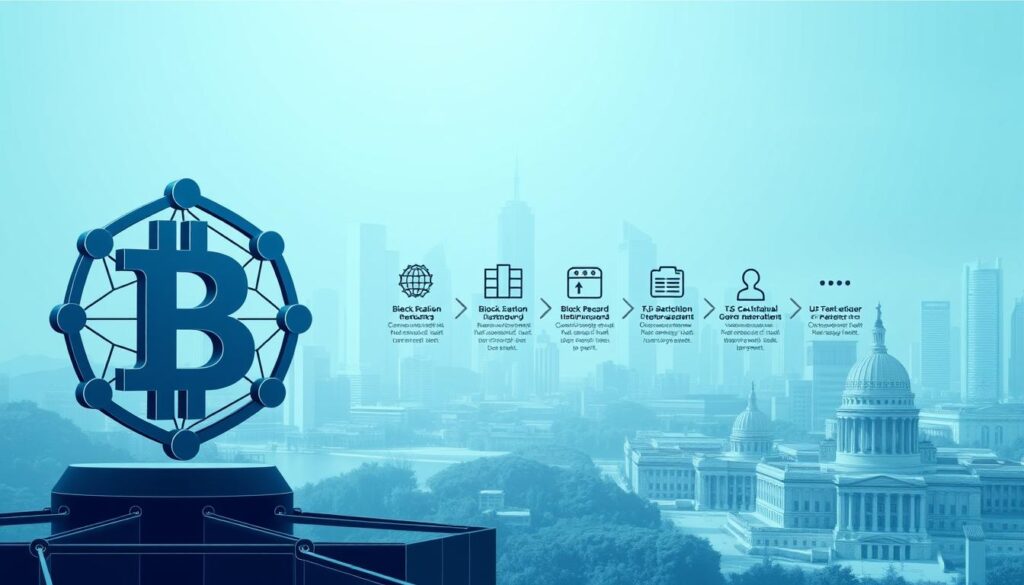Now Reading: Blockchain for Government Public Records Management: A Secure Approach
- 01
Blockchain for Government Public Records Management: A Secure Approach
Blockchain for Government Public Records Management: A Secure Approach

Official documentation holds immense value. These files form the backbone of civic trust and operational integrity. Yet, many current archival methods are outdated and vulnerable.
Centralized databases can be prone to security risks. Unauthorized access and data manipulation are real concerns. These weaknesses can damage public confidence in institutions.
A new technological framework offers a powerful solution. It creates a decentralized and unchangeable ledger for information. This innovation brings unprecedented transparency and protection.
This approach fundamentally changes how we handle vital information. It promises stronger security, lower costs, and greater accountability. It is reshaping the future of civic data stewardship.
Key Takeaways
- Traditional record-keeping systems face significant security and efficiency challenges.
- Data integrity and citizen trust are compromised by vulnerable centralized models.
- A decentralized ledger provides an immutable and transparent framework for information.
- This technology enhances security protocols and reduces administrative overhead.
- Streamlined compliance and increased accountability are major benefits for the public sector.
- Adopting this innovation can rebuild trust between institutions and the communities they serve.
Overview of Blockchain in Public Records Management
Digital innovation is transforming how civic institutions safeguard their most critical information. This new approach represents a fundamental shift from traditional centralized systems.
Understanding the Role of Blockchain in the Public Sector
Blockchain technology operates as a distributed digital ledger that verifies transactions across multiple computers. Unlike conventional databases, it doesn’t rely on a central authority.
Each participant maintains a complete copy of the entire ledger. This decentralized nature eliminates single points of failure. The system becomes more resilient against attacks and data breaches.
This technology offers significant advantages for the public sector. It enhances security through cryptographic measures like hashing and digital signatures. These features prevent unauthorized modifications to important documents.
Key Concepts: Decentralization, Transparency, and Immutability
Decentralization means distributing storage and verification across a network of nodes. This approach increases system resilience and reduces vulnerability.
Transparency ensures every transaction is visible on a shared ledger. Authorized participants can audit changes in real-time. This creates greater accountability throughout the process.
Immutability provides permanent, tamper-proof records. Once data is validated through cryptographic hashing, it cannot be altered without detection. This ensures long-term integrity of vital information.
These three principles work together to create a more trustworthy framework. They address core challenges facing traditional systems. This innovative approach to political transparency demonstrates the technology’s potential for broader civic applications.
The Need for a Secure Approach to Public Records
Conventional approaches to safeguarding vital information face mounting security challenges. Many existing archival methods cannot withstand modern threats. These weaknesses put sensitive civic data at constant risk.

Challenges in Traditional Public Records Systems
Centralized storage architectures create dangerous single points of failure. When one server or database is compromised, entire collections become vulnerable. Unauthorized access and data manipulation can occur without immediate detection.
The lack of visibility into modification history presents another critical issue. Without clear audit trails, errors and unauthorized changes may go unnoticed. This transparency deficit erodes public confidence in institutional integrity.
Operational inefficiencies further complicate these systems. Manual verification procedures and cumbersome retrieval processes delay crucial operations. Paper-based files and legacy digital systems struggle with cross-department coordination.
These vulnerabilities highlight why adopting advanced secure documentation solutions becomes essential. The protection of sensitive data requires more robust frameworks than traditional methods can provide.
Exploring Blockchain Technology for Government Applications
Network-based security models provide a robust alternative to vulnerable centralized storage approaches. These distributed frameworks offer enhanced protection for sensitive civic operations.

How Blockchain Enhances Security and Data Integrity
The decentralized architecture distributes information across multiple nodes. This makes unauthorized access exponentially more difficult. Attackers would need to compromise consensus across the entire network.
Cryptographic hashing creates unique digital fingerprints for each data block. These sequential links make retroactive alterations virtually impossible. The system maintains permanent, tamper-evident records.
Digital signatures authenticate user identities with precision. They create unforgeable audit trails for every transaction. This establishes clear accountability throughout the process.
Smart contracts automate critical security protocols automatically. They handle data validation and access control without human intervention. This reduces errors while enhancing system reliability.
These mechanisms translate into practical benefits for civic operations. Land titles, court documents, and identity information gain unprecedented protection. The technology represents a comprehensive security solution.
Implementing Blockchain for Government Public Records Management
The transition to advanced digital systems involves multiple critical phases. A well-structured approach ensures successful adoption of this innovative platform.

Step-by-Step Integration Process
Begin with a comprehensive assessment of current documentation workflows. Identify specific inefficiencies and security gaps that need addressing.
Select the appropriate technological architecture based on organizational needs. This decision impacts scalability and interoperability with existing infrastructure.
Develop a pilot program focusing on one department or record type initially. This controlled implementation allows for testing and refinement before full deployment.
Utilizing Smart Contracts and Automation
Smart contracts revolutionize administrative procedures through automated execution. These digital agreements handle validation and access control without manual intervention.
The technology significantly reduces processing time for routine tasks. Automated workflows minimize human error while maintaining strict compliance standards.
Integration with artificial intelligence enhances data categorization and retrieval capabilities. Natural language queries accelerate information access across departments.
This combination creates a highly efficient ecosystem for handling vital documentation. The implementation represents a fundamental improvement over traditional methods.
Enhancing Transparency and Trust with Blockchain
A new paradigm in civic data stewardship is emerging through distributed ledger technologies. This approach fundamentally reshapes how institutions maintain accountability with their communities.
Creating an Immutable Ledger for Public Records
The decentralized nature of this technology prevents any single party from controlling information. All participants operate on equal footing within a collaborative framework.
Every modification to documentation creates a permanent, timestamped entry. This creates a transparent audit trail visible to authorized stakeholders. The system’s cryptographic security ensures data integrity.
Citizens gain direct access to verify official information without intermediaries. This empowerment builds confidence in institutional processes. Individuals can independently confirm the accuracy of vital documents.
| Feature | Traditional Systems | Blockchain Systems |
|---|---|---|
| Data Modification | Can be altered without clear trail | Permanent, timestamped entries |
| Access Control | Centralized authority required | Direct citizen verification |
| Audit Capability | Periodic, resource-intensive | Real-time monitoring available |
| Trust Foundation | Relies on institutional reputation | Built on technological verification |

This technological framework enables continuous oversight of official actions. Both oversight bodies and community members can monitor changes simultaneously. The system creates unprecedented accountability in civic operations.
Real-world implementations demonstrate how this approach strengthens public confidence. As highlighted in recent analysis, the audit capabilities transform institutional relationships. The technology provides verifiable proof of procedural integrity.
Automating Compliance and Regulatory Standards
Regulatory compliance presents one of the most complex challenges facing modern administrative operations. Meeting standards like GDPR and HIPAA demands rigorous data handling protocols.
Traditional approaches require extensive manual verification processes. These labor-intensive methods strain institutional resources and increase error risks.
Streamlining Audits with Time-Stamped Entries
Distributed ledger technology revolutionizes compliance through automated verification. Each transaction receives a permanent timestamp that cannot be altered.
This creates an irrefutable audit trail for all documentation activities. Auditors gain immediate access to complete chronological records.
Smart contracts embed regulatory rules directly into workflow processes. They automatically validate actions against compliance requirements in real-time.
The system flags potential violations before they occur. This proactive approach prevents non-compliant actions systematically.
| Compliance Aspect | Traditional Method | Automated Approach |
|---|---|---|
| Audit Trail Creation | Manual documentation | Automatic timestamping |
| Verification Process | Resource-intensive reviews | Real-time validation |
| Error Detection | Post-facto identification | Preventive flagging |
| Administrative Overhead | High personnel requirements | Significant reduction |
This framework dramatically reduces administrative burdens. Personnel can focus on mission-critical tasks rather than compliance paperwork.
The technology also enhances privacy protection for sensitive information. Citizens maintain control over personal data while ensuring regulatory adherence.
Interoperability and Collaborative Government Systems
Seamless data exchange between different civic departments represents a major operational hurdle. Traditional information repositories often operate in isolation, creating significant coordination challenges.
This fragmentation leads to redundant data entry and inconsistent information across agencies. The lack of synchronized databases complicates inter-departmental collaboration.
Integrating Blockchain with Existing Legacy Systems
Modern blockchain platforms can bridge these gaps through sophisticated interoperability frameworks. They establish common standards that enable real-time data sharing across disparate systems.
The technology creates a synchronized database accessible to multiple departments simultaneously. This eliminates manual reconciliation processes that waste resources.
Property transfers demonstrate this advantage clearly. Multiple agencies need access to the same land registry information during transactions. A shared blockchain solution ensures all parties work with identical data.
Sweden’s land registry pilot achieved remarkable results. Property transfer times dropped from months to days using this integrated approach. The platform demonstrated how interoperability transforms bureaucratic processes.
Successful implementation requires careful planning for legacy system integration. Middleware solutions and API development enable gradual transition while maintaining compatibility.
Government organizations must also invest in technical training programs. Staff need skills to maintain these collaborative systems effectively. This ensures long-term success of integrated technology solutions.
Overcoming Regulatory and Technological Challenges
The path to modernizing civic data systems involves addressing critical challenges in legislation and workforce readiness. Organizations must navigate complex requirements while building internal capabilities.
Adapting to Legal Frameworks and Compliance Requirements
Many jurisdictions lack clear guidelines for distributed ledger applications. This creates uncertainty about data ownership and transaction validity.
The decentralized nature of these systems presents jurisdictional complications. Network participants may operate across different countries with varying requirements.
Close collaboration with policymakers becomes essential. Organizations must work with legal experts to develop comprehensive frameworks.
Investing in Capacity and Skill Development
Technical complexity requires significant workforce preparation. Staff need specialized knowledge to implement and maintain these solutions.
Governments should create comprehensive training programs. These initiatives equip employees with operational skills and strategic understanding.
Phased implementation and pilot programs help manage risks. Public-private partnerships provide valuable expertise during the transition period.
Building internal capabilities ensures long-term success. Continuous learning prepares organizations for evolving technological landscapes.
Innovative Applications of Blockchain in Government
Innovative digital solutions are expanding beyond basic documentation to transform civic engagement. These advanced implementations create more responsive institutions through enhanced security frameworks.
Secure Voting and Digital Identity Verification
Electoral systems gain unprecedented protection through distributed ledger technology. The Swiss city of Zug demonstrated this potential with a 2018 pilot project.
Each vote became an immutable transaction visible to authorized observers. This approach addressed longstanding concerns about election integrity.
Digital identity applications provide similar security benefits. Malta’s academic credential system using Blockcerts shows how verification becomes instantaneous. Employers can validate qualifications without lengthy processes.
| Application Type | Traditional Method | Digital Ledger Approach |
|---|---|---|
| Voting System | Manual counting and verification | Automated, tamper-proof recording |
| Identity Verification | Physical document presentation | Instant digital validation |
| Credential Authentication | Time-consuming background checks | Real-time cryptographic proof |
| Result Transparency | Limited audit capabilities | Complete transaction visibility |
Enhancing Public Service Delivery and Transparency
Land registry management demonstrates practical benefits for everyday services. Property transfers accelerate when ownership records are immediately verifiable.
Healthcare and business licensing also show significant improvement potential. Patients control access to medical documents while permits gain transparent tracking.
These diverse applications share a common strength: building trust through technological verification. Citizens experience more efficient services while institutions operate with greater accountability.
Conclusion
As we look ahead, the integration of advanced digital frameworks promises to revolutionize institutional accountability. This technology represents a fundamental shift in how we approach information security and civic operations.
The potential for enhanced efficiency and rebuilt public trust makes this transformation essential. However, successful implementation requires coordinated international standards and workforce development.
Looking to the future, applications like secure voting and digital identity verification demonstrate the way forward. These innovations will create more responsive institutions with greater transparency.
The journey toward widespread adoption demands vision and collaboration. By embracing this evolution, we can build systems that truly serve public interests for generations to come.
FAQ
What are the primary benefits of using this technology for official documents?
The main advantages include enhanced security, greater transparency, and improved data integrity. This approach reduces the risk of tampering and creates a trustworthy, verifiable history for items like land titles and permits.
How does a decentralized ledger improve trust in public sector processes?
Its decentralized nature means no single entity controls the information. Every transaction is time-stamped and visible to authorized participants, fostering accountability and building confidence among citizens and stakeholders.
Can this system work with our current legacy infrastructure?
Yes, integration is a key consideration. Solutions are designed to connect with existing databases and software through secure APIs, allowing for a phased implementation that minimizes disruption to current services.
What role do smart contracts play in automating government services?
Smart contracts automatically execute predefined rules. For example, they can instantly process a land transfer once payment is confirmed, cutting down manual steps and speeding up service delivery while ensuring compliance.
Is citizen privacy maintained when using this transparent platform?
A> Absolutely. While the ledger’s integrity is public, sensitive personal data can be protected through advanced encryption and permissioned access, ensuring only authorized officials view private details.
How does this technology help during official audits?
It streamlines audits by providing a permanent, chronological record of all actions. Auditors can easily verify the provenance and history of any document, saving significant time and resources.














